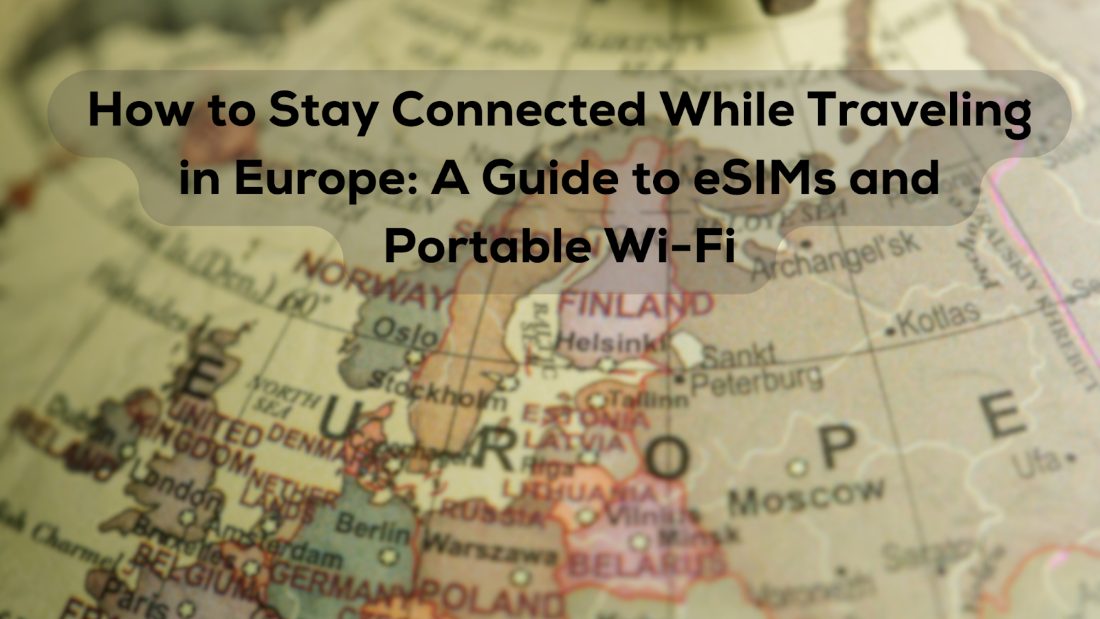Traveling in Europe and staying conveniently connected online can be a challenge. Navigating through exorbitant roaming fees, limited data plans, and spotty public Wi-Fi requires strategic planning to keep your devices powered up.
The good news is that innovations like eSIM cards and portable MiFi hotspots are making it easier than ever to stay connected while abroad.
This guide outlines everything you need to know to get online in Europe with minimal headaches. You’ll get tips on leveraging eSIM technology, renting pocket-sized Wi-Fi devices, locating free hotspots, and more.
With the right gear and some pre-trip preparation, you can avoid connectivity frustrations. Instead, you’ll be free to immerse yourself in creating unforgettable European adventures and memories. Read on to discover simple tricks for fast, reliable connectivity that will enhance your upcoming travels.
The Importance of Connectivity for Traveling in Europe
Having constant internet access is becoming increasingly vital when exploring Europe for several key reasons:
- Navigation Assistance:
Don’t get lost! Use Google Maps to navigate unfamiliar streets, transit systems, and more.
- On-the-Fly Research:
Quickly look up ratings, hours, reviews and details for sights, restaurants, and activities.
- Language Translation:
Bridge communication gaps with real-time translation apps like an esim para viajar a europa (eSIM for traveling to Europe). Don’t just rely on phrasebooks.
- Sharing Experiences:
Stay connected with friends, family, and followers by posting updates and photos.
- Handle Emergencies:
Access urgent information in case of health issues, travel delays, accidents and other unpredictable circumstances.
Data Source: Statista (see infographic below)
Choosing the Best Connectivity Option
When traveling in Europe, you have two main options to stay online: using your current smartphone’s cellular plan or renting/buying a separate mobile WiFi device. Here’s an overview:
Your Smartphone Abroad
The easiest option is to use your existing phone number and plan. But this often leads to expensive roaming unless you:
- Enable airplane mode and only connect via WiFi.
- Get an international roaming package.
- Unlock your phone and insert local SIM cards.
- Use an eSIM for seamless plan switching.
Renting a MiFi Hotspot
Another option is renting a portable WiFi device, such as Skyroam or GlocalMe. Benefits include:
- Avoid roaming fees.
- Conveniently connect multiple devices.
- Easily change countries without new SIMs.
- Battery life designed for travelers.
When choosing a rental, look for unlimited data, extensive coverage, good speeds, and fair rates.
Key Connectivity Considerations
Keep these factors in mind when picking the best connectivity solution:
- Destinations:
Will you primarily be in cities or rural areas?
- Trip length:
Short trips may rely more on public WiFi. Longer trips benefit from continuous access.
- Data needs:
Stream a lot? Prioritize unlimited data plans.
- A number of devices:
MiFi makes it easy to connect multiple gadgets.
- Local laws:
Some places require registering SIM cards. Research regulations.
- Budget:
Balance affordability and convenience based on trip duration.
Exploring eSIM Card Options for Europe Travel
One game-changing connectivity solution for Europe is the eSIM card. eSIMs are programmed with your plan details and store profiles digitally rather than on a physical SIM card. Here are some top benefits:
Easy Switching Between Plans & Providers
With an eSIM card, you can quickly switch between data plans as you cross borders. Save money by purchasing local data in each country. Top providers include Airalo, KnowRoaming, and AlwaysOnline.
No SIM Card Swapping Hassles
Traditional SIM cards require physically removing your usual SIM and inserting new ones in each country. eSIM allows you to digitally switch plans with the click of a button.
Use Your Number Abroad
Some eSIM companies like KnowRoaming provide you with a local number so you can use your smartphone as usual for calls, texts, and data.
Flexible Plans
Get exactly the data amounts you need whether it’s 1 GB or unlimited. With preloaded eSIM profiles, you can activate and switch plans on the fly as needed.
eSIM Compatible Devices
Many newer model iPhones, Google Pixels, and Samsung Galaxy smartphones support eSIM. Verify eSIM compatibility before traveling or consider upgrading if needed.
While eSIM tech was introduced in 2018, providers are quickly expanding coverage across Europe and North America. An eSIM is a great solution for staying connected without roaming fees or SIM card hassles.
Renting a MiFi Device for Seamless Travel Connectivity
Another excellent option for keeping Wi-Fi access abroad is to rent a portable Wi-Fi hotspot aka MiFi device. Here’s a look at how they work, and the top rental companies are:
How MiFi Devices Keep You Online
A MiFi device is a slim, battery-powered modem and Wi-Fi router in one. Here’s the gist:
- Connects via local cellular networks (4G LTE primarily)
- Creates a portable Wi-Fi hotspot to connect all your devices
- Works in over 100 countries with inexpensive data plans
- No roaming charges!
Top Providers
Leading MiFiRental companies include:
- Skyroam: Unlimited global data packages. Over 130 countries covered. Plans for 24 hours to months.
- GlocalMe: Affordable data rates. Extensive Europe coverage. Rentals or purchase.
- Google Fi: Uses “Fi pucks” as MiFi units. Strong domestic plan plus int’l coverage.
- XCOM Global: Generous bundled data amounts. Integrated SIM and battery for 85+ countries.
- Tep Wireless: Wide range of unlimited data packages tailored to each trip. Got “Best WiFi Rental” award.
When selecting a rental provider, compare rates, global connectivity, battery life, and the ease of pickup/return. A MiFi rental simplifies staying connected for individuals, couples, and groups.
Finding Free Wi-Fi Hotspots in Europe
Although eSIM cards and MiFi devices offer seamless connectivity, you can further reduce roaming charges by connecting to free public Wi-Fi when available in Europe. Here are some tips for finding hotspots when out and about:
- Cafés & restaurants – Buy a coffee and ask for the Wi-Fi password.
- Major public squares and parks – Check for city-sponsored hotspots.
- Museums & libraries – Free Wi-Fi is common in public institutions.
- Hotels and hostels – Often offer free lobby Wi-Fi even for non-guests.
- Airports – Connect while waiting for flights but beware of sluggish speeds.
- Public transit – Trains, buses, and stations increasingly offer complimentary Wi-Fi.
- Retail stores – Ask about Wi-Fi if dining or browsing for an extended time.
When connecting to public Wi-Fi, take basic security precautions like avoiding sensitive transactions. But taking advantage of free hotspots helps minimize cellular data usage.
Recommended Setup for Connectivity While Traveling in Europe
For the best combination of affordable reliability, we recommend this connectivity setup when traveling in Europe:
- eSIM card as your primary cellular data source. Switch plans easily.
- MiFi rental as a backup for areas with poor cellular infrastructure. Share the connection.
- Public Wi-Fi when available to further conserve mobile data.
- Offload media like playlists, movies, ebooks, and maps offline when possible.
- Limit bandwidth-heavy activities like video calls when rely just on Wi-Fi.
This blended approach prevents getting stuck with no connectivity while keeping costs reasonable. Feel free to use data liberally when you have Wi-Fi access to balance it out.
FAQs
Do I need an adapter to charge my devices in Europe?
Most likely, yes. Europe primarily uses 230v Type C or Type F plugs while the US uses 120v Type A/B plugs. Bring a universal adapter and verify device voltage capacities.
Can I use Google Maps offline?
Yes! Google Maps has an offline mode that lets you download maps and directions in advance via Wi-Fi and use them later without data.
Is it easy to get a European SIM card?
In most countries, yes. Shops aimed at travelers sell SIM cards with varying data amounts. Often you’ll need to register the SIM card with your passport info when purchasing.
How do I find free Wi-Fi abroad?
As highlighted earlier, cafés, public places, transportation hubs, hotels, stores, and restaurants often offer complimentary Wi-Fi. Also check city tourism sites for free hotspot directories.
How do I enable Wi-Fi calling on the iPhone?
Under Settings > Phone, toggle on Wi-Fi Calling and enter an emergency address. This allows calling over Wi-Fi when cellular networks are unavailable. Only works on select carriers.
Key Takeaways for Staying Connected in Europe
Staying online in Europe takes a bit more forethought than typical domestic trips. To summarize, focus on:
- Researching eSIM and MiFi options that meet your travel needs and budget.
- Unlocking your smartphone if using a local SIM card.
- Identifying spots offering free public Wi-Fi.
- Downloading content like maps, music, books & language packs in advance.
- Budgeting some time without connectivity in rural areas.
- Pack chargers, batteries, & power banks to avoid losing juice.
Conclusion
Although maintaining mobile connectivity requires some effort, the ability to access maps, travel information, and share experiences smoothly makes it worthwhile.
With the right gear and preparation, you can stay connected conveniently while discovering the magic of Europe.
We hope this guide helps you stay conveniently connected on your next trip to Europe. Safe travels!
Read Also:













